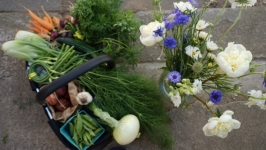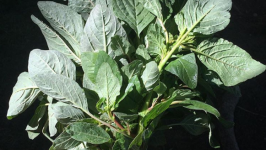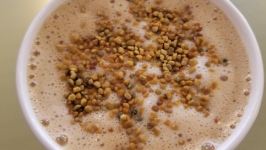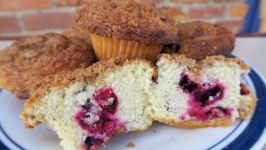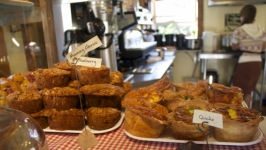State of the Foodshed
As a farmer, I prefer keeping my head down, literally in the dirt, focusing on the little universe of my farm. However, winter forces me to push the pause button, to come up for air and take a look around. This winter’s process has been especially celebratory—it seems the seedlings of so many folks’ labor to build regional foodsheds here in Idaho are starting to bear fruit.
When seedsman Bill McDorman gave the keynote address at the first-ever Southern Idaho Sustainable Agriculture conference nearly 30 years ago, he addressed an audience full of bright-eyed, bushy-tailed young versions of many of our beloved elders in the farming movement today: Janie Burns, Mike Heath, Nate Jones. He said that their work to learn how to farm organically is for nothing if they don’t have people who want to buy their food. Fast forward 30 years and more people than ever are seeking out locally grown food. Our state now houses almost 50 farmers markets, dozens of CSAs and an increasing number of restaurant and institutional buyers looking to source local food.
I have so much respect for the pioneers of this movement. They not only had to figure out how to farm organically, which was new and different for most of them, they simultaneously had to convince people to want to buy and eat their products. They had to build a market for their food at the same time they were learning to grow it. Diane Green in Sandpoint literally wrote the book—it’s called Selling Produce to Restaurants—on how farmers can work with chefs to get their produce into restaurants. All these years later, she’s still selling to restaurants, but now they seek her out. Now, there are over 15 restaurants buying her produce as well as food from other area farmers. Her efforts helped pave the way for new farmers to have a market for their food.

Traveling to farming conferences on the West Coast as many of us do in the winter, it’s historically been easy to get discouraged by how far behind the curve Idaho can seem. Our rugged state, separated by expanses of desert and forest wilderness, can make us feel lonely and isolated. Small-scale and organic farmers in our neighboring states enjoy a robust suite of support systems farmers in Idaho can only dream about. Washington hands grants out the wazoo to beginning farmers and ranchers. Oregon puts agricultural land around its cities into land trusts, giving farmers affordable leases on it as well as six months of unemployment benefits while they get their new businesses off the ground. All those West Coast states allow farmers to grow the most lucrative cash crop around (weed) while our dear state has charged out of the gate to ban growing even its newly federally legalized cousin, the über-practical puritanical hemp.
And yet, in these last few years many of us have had the feeling we’re not so far behind at all when seeing how we measure up at the conferences. This winter, Mike Sommer at Purple Sage Farm went to Eco-Farm, the granddaddy of all organic farming conferences, and was happy to report there wasn’t anything earth-shattering on display there that somebody around here wasn’t already working on.
In my own work with the Snake River Seed Cooperative, I’ve seen the same step-bystep growing of a tiny seed into a functioning business that serves farmers and community members alike. Though our region has a long history of seed production, when I started nobody was selling their seeds to our area; instead all the Idaho-grown seeds were shipped to distant seed companies. Ten years ago, I started growing a few seeds on my farm, putting them into packets and selling them at a couple Boise garden centers. In 2018, SRSC had 36 farmers from Idaho and surrounding states. We are collectively stewarding over 300 varieties of seeds and selling them at dozens of natural food stores and garden centers all over the state. Ten years ago, a gardener who wanted to plant a locally grown seed in her garden couldn’t do that unless she saved it herself or got it from a seed-saving friend. In 2018, over 40,000 packets of locally grown seeds made their way into the hands of Idaho gardeners.
“It’s working,” I say to myself, shaking my head. “I can’t believe it, but it’s actually working.”
All around the state there is evidence of our little movement gelling into a bona fide food system. The Nez Percé and Coeur d’Alene tribes are engaging in food sovereignty work. Each year more folks start small farms, set up farm stands, lug their wares to farmers markets or into the back doors of restaurants where chefs whip it into compelling, economy-feeding seasonal dishes. We even just gotour state’s first certified organic extension and research center in Sandpoint!

As local food systems evolve, they also often begin incorporating meat, bean and grain production into the usual array of farmers market vegetables. All over Idaho folks are tackling grain crops, particularly heritage grains, and slowly but surely they’re piecing together the infrastructure to incorporate them into our diets. Micro-malters in the north and micro-mills in the south are making it possible for folks to take up grain growing on a smallerscale, which allows for more diversity in the varieties being planted.
One of the challenges for organic farmers trying to grow wheat is that modern wheat varieties have been bred alongside large applications of ammonium nitrate fertilizers and farmers find it hard to get the protein levels in their crops up without the addition of those fertilizers. Gaston’s Bakery owner Mathieu Choux recently returned from studying in France, where he learned to work with these lower-protein grains and has purchased a Unifine mill to help in this process. It can mill whole wheat in a way that makes it act more like white flour for the baker. And since protein is gluten and modern wheat production is fueling our population’s rising gluten intolerance, having the skill and equipment to work with lower-protein whole wheat is a big deal.
Idaho farmers are exploring and producing a variety of ancient grains, including heritage wheat varieties that are better adapted to the organic systems they evolved in than the modern chemical-hungry varieties. Farmer Jade Koyle in Teton is now the nation’s largest grower of the ancient wheat einkorn. And Tim Cornie in Buhl has purchased the massive 145,000-square-foot Seneca Foods plant and turned it into 1000 Springs Mill, which will allow our region to scale up production of other grains that prove successful when grown on a smaller scale.
It’s a natural progression for market farmers to start out in vegetables and, once they’ve established their business and gathered some resources, diversify into agricultural enterprises with bigger or longer-term infrastructure needs: livestock, orchards, dairies, value-added products. In diversifying, they open up the fresh vegetable market for other beginning farmers, allowing the next generation to be able to jump in and grow veggies while finding their niche. Iconic Boise farm Peaceful Belly just opened their hard-earned Vine and Branch Ranch, where they’ve diversified into hard-cider making, classes and a farm-to-table restaurant. Without them at the indoor winter Boise Farmers Market, several newer produce vendors noticed a big spike in their sales.
Even big chain stores like Walmart and Albertsons are trying to cash in on the local food craze, and while that runs the risk of local-washing and watering down our movement, it also proves, as long time Palouse local food advocate Colette DePhelps says, that “there has been a lasting consumer shift and an increased desire to buy local.”
It’s not normally like me to take such a rosy view, and to be sure, there’s plenty of struggle in this movement too. But it does feel good to stop every once in awhile and take stock of how far we’ve come. Thanks to all the people in the movement—past, present and future—who are piecing together a functioning food system right before our very eyes. By God, it seems to be working!
Bill McDorman
Southern Idaho Sustainable Agriculture
Janie Burns
Selling Produce to Restaurants
Gaston’s Bakery | @gastonsbakery
1000 Springs Mill
Peaceful Belly | @peacefulbelly
Vine and Branch Ranch | @vineandbranchranch
Boise Farmers Market | @boisefarmersmarket



